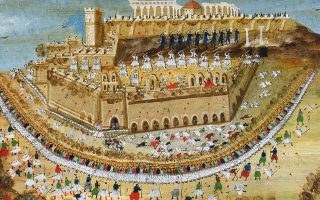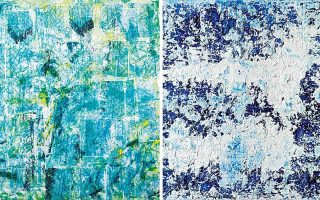Fashion designer Yannis Tseklenis honored with career-spanning show

Yannis Tseklenis was on a business trip when his hotel room phone rang on February 6, 1982, and he learned that the Education Ministry had decided to abolish the Greek school uniform as of the next academic year.
The huge sigh of relief by thousands of pupils across the country went unheeded by the clothing designer for whom the decision was yet another major career blow: Some 300,000 meters of special blue fabric produced by the Peiraiki-Patraiki textile company had just been consigned to the trash heap.
The ministry’s decision prompted an uproar from those parts of the clothing manufacturing and retail industry that relied on school uniforms and had already started preparing for demand ahead of the next academic year.
In Komotini in northern Greece 170 workers lost their jobs at the main plant that made the uniforms and the surplus fabric was put in storage, where it simply rotted. Greece was on the path of its great, post-dictatorship change, but for many, like Tseklenis, fears of economic disaster loomed large.
In light of the exhibition “Tseklenis: The Fashion Years,” co-organized by the Peloponnesian Folklore Foundation and the cultural venue Fougaro in the town of Nafplio, where it is being hosted, Kathimerini met with the designer at his Athens office in downtown Metaxourgeio.
It was particularly warm in the old building on Kolonos Street, yet Tseklenis was dapper in a stylish blue button-down shirt, surrounded by his photographs, books and models of his work. He was energetic and direct, pacing as he talked and looked for newspaper clippings on his work. “I turn 81 on November 6 yet not for a moment have I entertained the idea of stopping. I have no intention of making myself useless,” he said.
Some say that he has been lucky: The rebellious son of a competent textile merchant who had one of the first stores to open on Athens’s Ermou Street, he was spoiled, handsome, athletic and a bon viveur. He learned the business at the family store and received his father’s blessing to continue in fashion, an area for which he had shown talent early on. He set out to build a Greek brand with an international reputation, and he achieved it – before he lost it all.
“If I were French or Italian, my father’s advice that I go into fashion would have been a blessing. But because I am Greek, it was like being thrown into a pit of vipers,” he said.
Others regard Tseklenis as unlucky: The ambitious young man who went on to evolve into a talented artist and a bold and visionary businessman with 300 stores around the world by the age of 30 and nine factories producing his clothing, who took Greek fashion global, conquered New York and rubbed shoulders with Aristotle Onassis, and who was named by Esquire in 1972 as one of the greatest fashion designers of the 20th century, was diagnosed with an aggressive form of skin cancer when he was 40. He also went bankrupt when his creditors learned of his illness. With huge debts and very little cash, he set off for the United States, not knowing when or if he’d be back. He flirted with the idea of traveling to French Polynesia to die a romantic death there like the poet Jacques Brel. He didn’t do it because life just would not let him be. He kept working, he went into remission after losing his left hand to the illness and then he made his comeback.
Tseklenis came back home. “Even though I was having a good time in New York, I would cry every time I spoke of Greece,” he said, explaining why.
It was the late 1970s when he came back and thanks to the help of friends and especially of the pioneering businessman and owner of the Minion department store, Yiannis Georgakas, was also able to get back on his feet. He established a new company, Tseklenis International, which manufactured and distributed the Tseklenis brand in Greece and abroad. He designed school supplies and a line of famous safari-style uniforms, with large breast pockets and pen holders that looked like bullet loops. It was a huge success, but just a few days before Christmas 1980, Minion burned down, torched by the “October 80 Revolutionary Organization” in retaliation for its “exploitation of the proletariat.” It was a huge blow for Tseklenis, who sustained significant economic losses. Then the school uniforms were abolished.
“It takes practice to survive,” he said of how he handled so much bad luck. “Everything can come crashing down in a single moment and then what counts is survival – being alive, eating, drinking, laughing, falling in love.”
Career trajectory
Tseklenis made his foray into women’s fashion after taking over the family business, which supplied local manufacturers, seamstresses and a handful of high-end brands with mostly imported fabrics. He didn’t want to go abroad to study textiles. “I felt that there was no future in textiles. I wanted to start working here, get into business and do art,” he says. “Greece was still in the dark in the mid-1960s. Tourism had started growing, but very few people abroad knew of us.”
But textiles were his business, so he designed his first collection of fabrics in 1965, presenting silk made in Soufli in northern Greece – which was one of the world’s biggest producers at the time – with his original prints. Greece was experiencing serious political turmoil at the time, but the collection was still promoted in a major campaign titled “The Greek Fashion Odyssey,” in cooperation with the Greek National Tourism Organization, Aristotle Onassis, Olympic Airways and Metaxa, the brandy maker. The campaign was launched in February 1967 and was expected to run through the summer, but the military coup in April sucked all the wind out of its sails.
Nevertheless, Tseklenis had made it onto the global fashion map with his textiles and with complete clothing collections. Meanwhile, despite the seven-year dictatorship, and “its depressing atmosphere,” the weaving and knitting sector took off, with dozens of factories opening around Greece. By the late 1970s, Greece was exporting 2.5 billion dollars’ worth of textile products and clothing.
“Unfortunately, the bulk of exports comprised no-brand products, as all of the marketing, the design, the executive work and the distribution was carried out by foreign fashion houses,” said Tseklenis. The sector all but collapsed when Greece joined the European Community in 1992. The rising cost and demand for faster production, coupled with the end of state protectionism, destroyed the Greek textile industry.
Tseklenis quietly retired from the fashion industry in 1991 with one last collection and now works in interior design, creating interiors for airplanes, ships and public transportation. “The younger kids don’t even know my name,” he said.
Does he mind? “Not at all. In fashion, you learn to live with the ephemeral.”
“Tseklenis: The Fashion Years” runs through November 25 at Fougaro (98 Asklipiou, tel 27520.473.00). Opening hours are Thursdays & Fridays 11 a.m. – 2 p.m. & 5-10 p.m., Saturdays 11 a.m. – 10 p.m. and Sundays 11 a.m. – 8 p.m.





